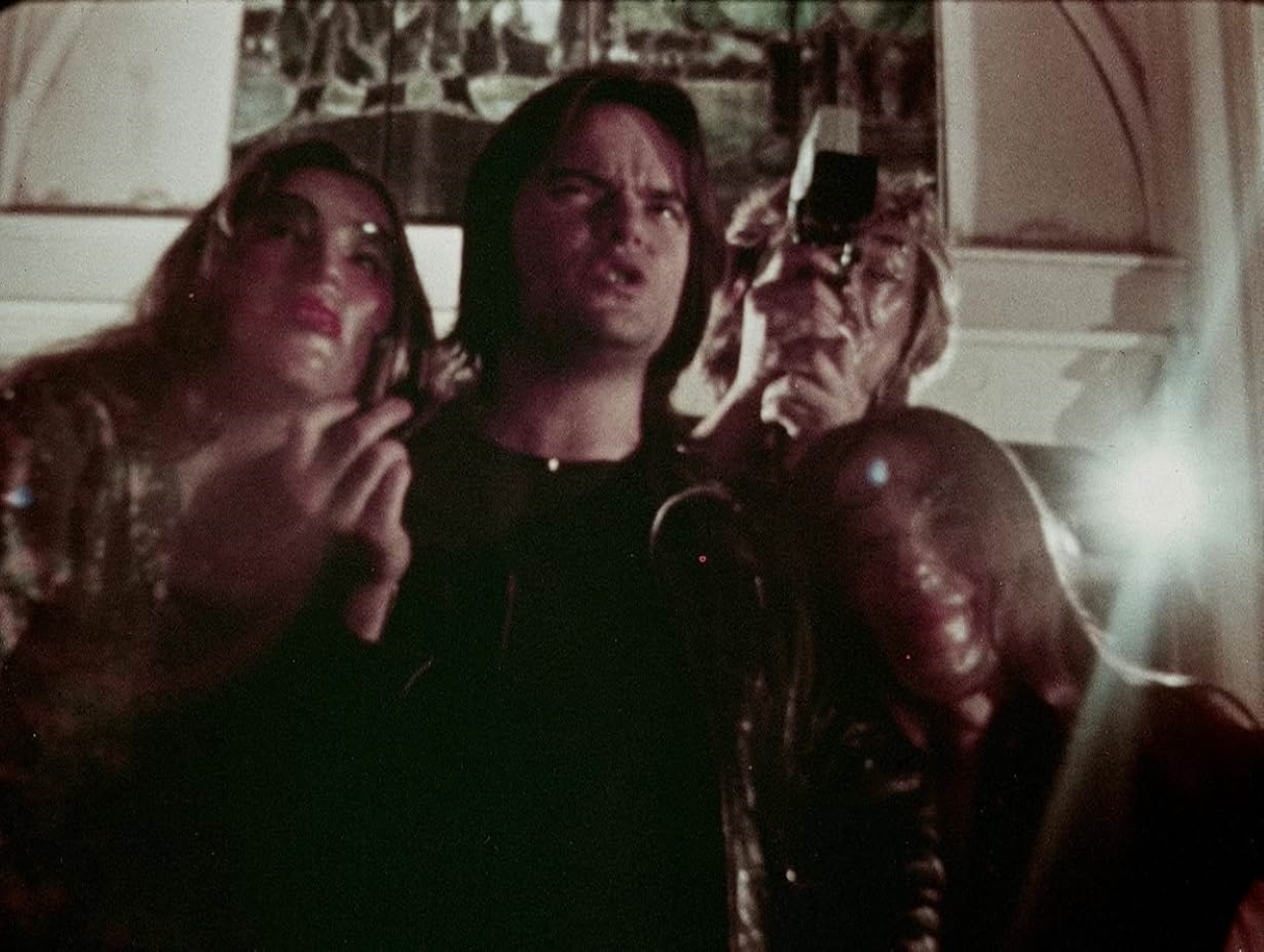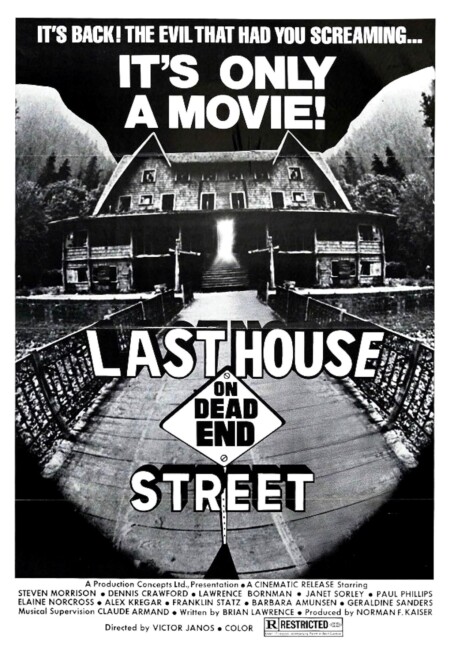Crew
Director – Victor Janos [Roger Michael Watkins], Screenplay – Brian Laurence, Producer – Norman F. Kaiser, Photography – Alexander Tarsk, Music Supervisor – Claude Armand, Special Effects/Makeup Effects – Kevin Heatley, Art Direction – Olivia Carnegie. Production Company – Today Productions, Inc.
Cast
Steve Morrison (Terry Hawkins), Barbara Amunsen (Nancy Palmer), Alex Kregar (Steve Randall), Franklin Statz (Jim Palmer), Dennis Crawford (Ken Hardy), Lawrence Bornman (Bill Drexel), Janet Sorley (Kathy Hughes), Elaine Norcross (Patricia Kuhn), Geraldine Saunders (Suzie Knowles)
Plot
Just released from jail, Terry Hawkins decides that he wants to make a movie. He brings a porn producer and director and the director’s wife, along with several others, to an abandoned building. There he and his friends gleefully torture and kill the group, all the while filming this.
The Last House on Dead End Street has an exploitation notoriety. It was made during the 1970s in the period when a host of films determined to go for broke and brutalise audiences in a big way – see the famous like of The Last House on the Left (1972) and The Texas Chain Saw Massacre (1974). The Last House on Dead End Street languished in notoriety and unavailability for many years, existing only in bootleg or foreign language versions, up until a thorough dvd package was put together in 2002 by Barrel Entertainment, a company that specialise in releasing really out there films.
The Last House on Dead End Street has a production history that is almost more interesting than the film is. It started as a project in 1972 when director Roger Michael Watkins was seeking to break into the film industry. Like both Tobe Hooper and Wes Craven, Watkins theorised that the best way to make an impact was to create a film that shocked people. Watkins was inspired by rumours that members of the Manson Family had made snuff films. He set out shooting the film under the title The Cuckoo Clocks of Hell, a phrase taken from writer Kurt Vonnegut. The film was shot over 1972-3 with Watkins himself playing the lead torturer, credited as Steve Morrison on the end film. After a fired cast member complained to police, the production was held up in court on obscenity charges, although was eventually cleared.
The finished film was released in 1977 under the most well-known title The Last House on Dead End Street in a clear attempt to exploit the success of Wes Craven’s The Last House on the Left. Watkins expressed considerable outrage at the distributors who not only cut his original version of the film, which ran at some 175 minutes, down to 77 minutes, but also retitled it and changed the names of all of the cast and production personnel. In fact, Watkins was not even aware that the film had been released until some time after it was. Subsequently, Roger Michael Watkins went onto a career as a porn director with films such as Her Name Was Lisa (1979), Cosmopolitan Girls (1981), The Pink Ladies (1981), Spittoon (1981), Corruption (1983), Midnight Heat (1983), American Babylon (1987) and Decadence (1988), before his death in 2007.

Aside from Snuff (1976), which was made around the same time but not released until later, The Last House on Dead End Street was one of the first films to take up the theme of Snuff Movies. For all its comparison to classics like The Texas Chain Saw Massacre and The Last House on the Left, The Last House on Dead End Street feels more down around the level of sordidly nasty films like Blood Sucking Freaks (1976). It is hard to ascertain the full impact of the film as much of it has either been censored or cut. The missing 100 minutes do include a number of scenes that dealt with character development. In what we have left, there are lots of scenes of people laughing madly and killings that are seemingly shot handheld.
The great problem of The Last House on Dead End Street is that we never know enough about any of the characters to care about their deaths. They are just faces and so there is no shock value to seeing what is in effect random strangers being killed. That said, some of the levels to which Roger Michael Watkins is prepared to push the film have a considerable brutality. Particularly nasty is a scene where Barbara Amunsen is tied to a table and her face sliced with a scalpel, before her legs are sawn off and Morrison/Watkins climbs on top and cuts into her guts with a pair of bolt cutters and starts pulling out her intestines. The scene is undone somewhat by the fake looking blood but has an undeniably full-on rawness and nastiness. In another scene, Alex Kregar is forced by a topless woman to fellate what looks like a goat’s hoof and then gets a power drill in the head. To unsettle us in the opening moments, Watkins throws in images of cattle having their throats slit in slaughterhouses.
On most technical levels, The Last House on Dead End Street is amateurish and poorly made. (To perhaps give Roger Michael Watkins his due, he does claim that he was out of his tree on crystal meth throughout shooting). There is no plot that drives the film – just a progression of scenes. Most of these have the feel of a film where random pieces of footage have been slung together and shot whenever the director could – something that Edward D. Wood Jr was notorious for. There is a mix of different film stocks, as well as long tedious nudie sequences that go on and on and feel like they were shot for another film altogether.
One of the other aspects about the film that irritates is the addition by the distributors of a title card that tells us that the killers were eventually apprehended. It has the same effect as the tacked-on coda in Invasion of the Body Snatchers (1956), which feels inserted to leave audiences going out with the comforting assurance that forces of law and order will always win out.


